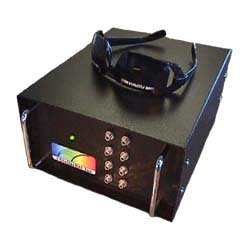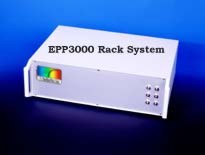|
|
IEEE 1284 Digital Parallel Port interface
(EPP)
Research grade signal to noise of 20,000:1
Synoptic input channels with up to 12 fiber inputs
Cooled CCD with Dynamic range of 50,000
Rack Mount option with Integrated Light Source
Concave holographic aberration corrected grating for UV
Windows95/98/NT/Dos/LabVIEW software drivers
Economical system for multi-channel dissolution testing, measuring solution
absorbance and transmission.
|
|
The StellarNet EPP3000 fiber-optic UV+VIS
spectrophotometer is a high performance instrument designed for use in
either a laboratory or process environment. Its excellent sensitivity
and flexible exposure times make it useful for high light absorbance/transmission
measurements and low light applications such as fluorescence. The 64 (verticle)
x 1024 element detector is a wide dynamic range CCD, cooled by a single-stage
thermoelectric cooler. Each element is a 24 x 24um pixel. The first 400
pixel-columns are lumogen coated for UV response. A holographic flat-field
grating is employed for wavelength coverage of 190-790 nm.
UV/VIS Spectrometers StellarNet provides
both low cost and research grade UV/VIS spectrometers for routine and
at line process measurement of sample absorbance, transmittance, and reflectance.
The spectrometer wavelength range covers 200-850nm or 190-790nm depending
on the model selected. The units incorporate UV enhanced CCD detectors
with multi band coatings to minimize second order wavelength detection.
25um slits are permanently installed to set resolution at 0.75nm across
their UV+VIS operating range. The optics incorporate a 40mm diameter concave
grating that produces an aberration corrected, flat field onto the detector.
Without mirrors, the grating provides superb image quality and maintains
low stray light. The EPP2000C spectrometer model can be daisy-chained
to allow DUAL BEAM configurations as well as other multi-channel configurations
for process monitoring. Photo Diode Array detector options are available
to increase the signal to noise for demanding UV/VIS applications. The
instruments are constructed in a small metal enclosure of 6x4.25x2.75
inches, with a fiber optic SMA connection on the front panel. The unit
connects digitally to a printer connector on a PC or notebook computer.
The units have an integrated data digitizer with a 4096magnitude for any
detector integration period. The detector can be selected to integrate
from 4 milliseconds right up to 60 seconds, extending the detection limits
for small signals. The units provide 7 decades of dynamic range. A decade
of dynamic range includes the selected integration period * 2. Portable
spectrometers include IEEE1284 interface cable and +5VDC power adapter
for 120VAC-60HZ. Light sources include +12VDC power adapter for 120VAC-60HZ.
These power adapters are small wall mount transformers with U.S. style
2 prong plugs. For usage outside the U.S.A., we offer an upgrade to universal
power adapters. Connecting the spectrometer to a second EPP printer port
on your computer is most convenient and recommended. For portable notebook
computers that don't have an EPP capable printer port, we offer the PCMCIA
card style EPP interface. The EPP3000C model provides 8 fiber optic inputs,
stacked in a line, that are focused onto the concave grating through a
25um slit. The cooled Hamamatsu CCD detector receives the "stacked" image,
and with the help of an integrated DSP (digital signal processor), separates
the optical image into discrete spectral channels. The unit has an integrated
16 bit A2D data digitizer with correlated double sampling to provide a
signal to noise of 20,000:1 with a dynamic range of 50,000. The unit is
provided in a metal enclosure with 8 fiber optic SMA input connectors,
100-240VAC power input (47-63Hz), IEEE1284 interface cable and EPP-PCI
adapter card. The unit is capable of reading 10 samples per second on
all 8 channels.
|

